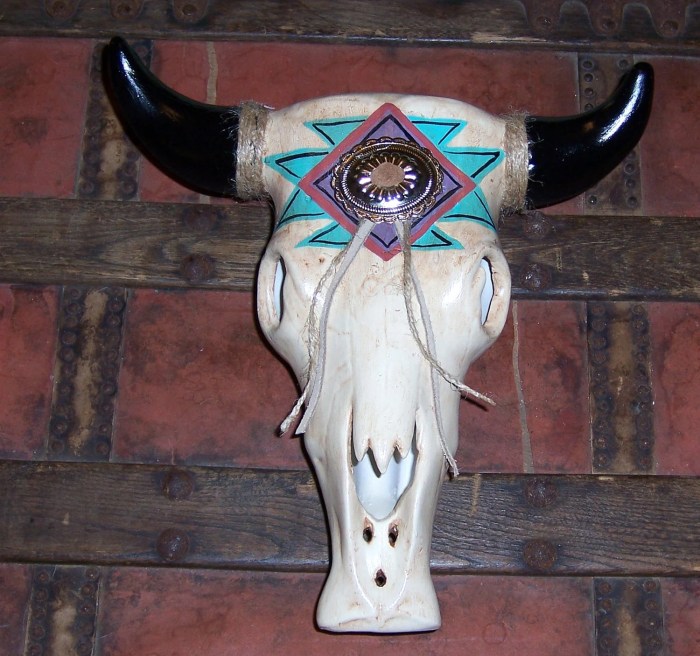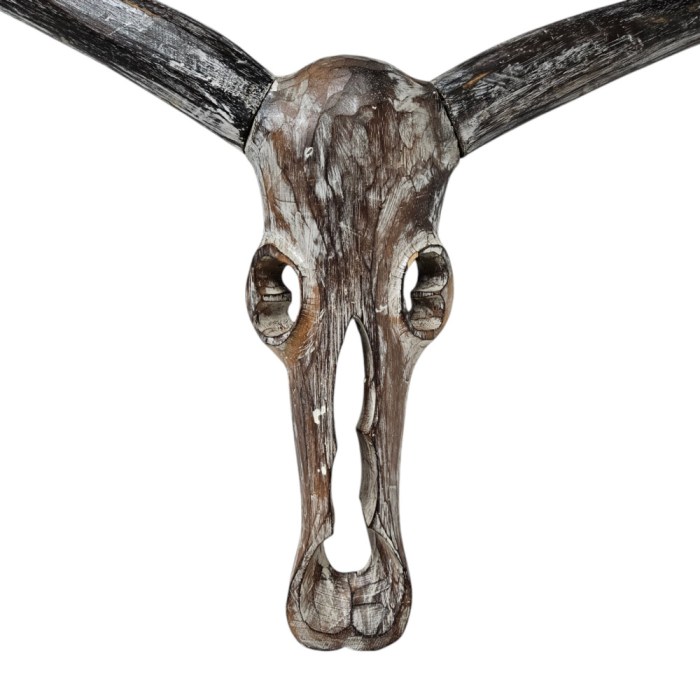Cow Skull Decor: From ancient cultural symbols to contemporary artistic expressions, the use of cow skulls in decoration spans centuries and cultures. This guide delves into the rich history, diverse styles, and artistic potential of cow skull decor, exploring its symbolic meanings, practical applications, and ethical considerations. We’ll examine various decorative techniques, showcase stunning examples, and offer insights into integrating this unique element into modern interior design.
We’ll journey through the historical significance of cow skulls in different cultures, analyzing their symbolic representations and evolving roles in decorative arts. We’ll then explore the myriad ways cow skulls are transformed into striking decorative pieces, from simple bleached skulls to intricately painted and embellished works of art. Finally, we’ll provide practical advice on sourcing, preparing, and decorating cow skulls responsibly, along with ideas for seamlessly incorporating them into your home’s aesthetic.
History and Cultural Significance of Cow Skulls in Decor

The use of cow skulls in decorative arts spans centuries and diverse cultures, revealing complex symbolic meanings and evolving aesthetic preferences. While often viewed with a modern lens of macabre fascination, the historical context reveals a deeper engagement with life, death, and the cyclical nature of existence. Understanding this historical perspective is crucial to appreciating the diverse interpretations of cow skull décor.
Cow Skull Symbolism Across Cultures
The symbolic meaning attributed to cow skulls varies significantly depending on cultural context. In many indigenous American cultures, particularly those of the Southwest United States and Mexico, the cow skull represents the power and strength of the animal, often linked to the sun and fertility. The skull’s inherent symbolism of death is frequently intertwined with regeneration and the promise of new life, reflecting a deep connection to the land and its cycles.
Conversely, in some European traditions, the cow skull, particularly when bleached white, might have been associated with the concept of memento mori – a reminder of mortality. This perspective often encouraged contemplation of life’s transience and the importance of living virtuously. The difference in interpretation highlights the contextual nature of symbolic meaning.
Regional Variations in Cow Skull Decor
Three distinct regions illustrate the diverse approaches to cow skull décor. In Mexico, particularly in rural communities, decorated cow skulls –calaveras* – are central to the Day of the Dead celebrations. These are often vibrantly painted with bright colors, intricate designs, and personal messages, transforming a symbol of death into a joyful and celebratory object. In contrast, Native American tribes in the American Southwest frequently incorporated cow skulls into ceremonial regalia and artwork, employing them as symbols of power and connection to the natural world.
The aesthetic is often more subdued, emphasizing natural textures and colors. Finally, in certain parts of Europe, particularly in areas with strong agricultural traditions, cow skulls might have been displayed more functionally, perhaps as a trophy representing a successful harvest or a reminder of the animal’s contribution to sustenance. These examples show a wide range of uses and artistic approaches.
A Timeline of Cow Skull Use in Decorative Arts
The use of cow skulls in decorative arts is not easily pinned down to precise dates, as many practices were passed down orally through generations. However, a general timeline can be constructed:
Pre-Columbian Era (before 1492): Cow skulls, or those of related bovine species, were likely incorporated into ceremonial and decorative practices in various indigenous cultures of the Americas, though specific examples are often limited to archaeological findings.
Post-Columbian Era (1492 onwards): The introduction of European cattle to the Americas led to a wider availability of cow skulls. This coincided with the development of unique styles of decoration in both indigenous and European-influenced communities.
19th and 20th Centuries: The use of cow skulls in decorative arts continued, evolving in response to changing cultural trends and artistic movements. The rise of the Ranch aesthetic in the American West contributed to the incorporation of cow skulls into home décor, often alongside other rustic elements.
21st Century: Cow skull décor remains a popular motif, particularly in contexts that evoke themes of rustic charm, southwestern style, or memento mori. However, its interpretation and use continue to evolve, reflecting contemporary artistic sensibilities and cultural awareness.
Types and Styles of Cow Skull Decor
Cow skull decor transcends mere ornamentation; it’s a multifaceted art form reflecting diverse cultural influences and artistic expressions. The inherent symbolism of the skull, combined with the unique texture and shape of the bovine cranium, provides a rich canvas for creativity. The resulting pieces range from rustic and minimalist to flamboyant and intricately detailed, offering a wide spectrum of styles to suit various aesthetics.
The versatility of cow skulls as decorative elements stems from the ease with which they can be adapted to different styles and techniques. The natural bone structure provides a strong base, while the surface lends itself well to a variety of treatments and embellishments. This adaptability allows for the creation of pieces that range from stark and minimalist to intensely ornate and colorful.
Bleached, Painted, and Embellished Cow Skulls
This section details the different ways cow skulls are transformed into decorative pieces, focusing on the materials and techniques used. The most common approaches involve bleaching, painting, and embellishing the skulls with various materials.
Bleaching is often the first step, creating a clean, uniform base. This process removes the natural color and impurities, revealing the bone’s natural texture. Paints, ranging from simple acrylics to more durable outdoor paints, allow for an infinite array of colors and designs. Embellishments can include beads, metal accents, feathers, and even repurposed materials, adding layers of texture and visual interest.
The choice of materials and techniques significantly influences the overall style and aesthetic of the finished piece.
Design Examples of Cow Skull Decor
Three distinct styles illustrate the versatility of cow skull decor:
Style 1: Rustic Farmhouse: This style emphasizes a natural, unrefined aesthetic. A bleached cow skull is mounted on a reclaimed wood plaque, possibly with a simple, hand-painted floral design in muted earth tones. The overall feel is understated elegance, emphasizing the natural beauty of the materials.
Style 2: Boho Chic: This style incorporates vibrant colors and eclectic materials. A cow skull is painted in bright, jewel tones, adorned with colorful beads, feathers, and small metal charms. The overall effect is vibrant and playful, reflecting a free-spirited and bohemian aesthetic.
Style 3: Modern Minimalist: This style prioritizes clean lines and a monochromatic palette. A bleached cow skull is mounted on a sleek, black metal stand. The focus is on the skull’s inherent form and texture, with no additional embellishments to distract from its simple elegance.
Examples of Cow Skull Decor Styles
| Style | Materials | Origin (Example) | Description |
|---|---|---|---|
| Rustic Farmhouse | Bleached cow skull, reclaimed wood, acrylic paint | United States (rural areas) | Simple, understated design emphasizing natural materials and muted colors. |
| Boho Chic | Painted cow skull, beads, feathers, metal charms | Mexico | Vibrant colors and eclectic materials create a playful, free-spirited aesthetic. |
| Modern Minimalist | Bleached cow skull, black metal stand | Contemporary design studios | Clean lines and a monochromatic palette highlight the skull’s inherent form. |
The Making of Cow Skull Decor

Transforming a cow skull into a decorative piece requires careful preparation and attention to detail. The process involves several steps, from ethical sourcing to the final artistic touches, each demanding respect for the animal and a commitment to safe handling practices. Understanding these steps ensures both a beautiful finished product and a responsible approach to creating this unique type of décor.
Preparing a Cow Skull for Decoration: A Step-by-Step Guide
The initial stages of preparing a cow skull are crucial for achieving a clean and aesthetically pleasing final product. Improper handling can lead to damage or the persistence of unpleasant odors. The following steps Artikel a safe and effective method. First, the skull must be thoroughly cleaned of any remaining soft tissue. This can be achieved through a combination of methods, including careful scraping with a blunt instrument and enzymatic degreasing.
Subsequently, the skull should be meticulously cleaned using a strong stream of water to remove any residual debris. Finally, allow the skull to dry completely before proceeding to the next stage.
Cleaning and Bleaching Techniques for Cow Skulls
Several methods exist for cleaning and bleaching cow skulls, each with its advantages and disadvantages. One common method involves soaking the skull in a solution of hydrogen peroxide, which effectively bleaches the bone to a bright white. The concentration of the peroxide and the duration of the soak will determine the final whiteness. Alternatively, a natural bleaching method involves exposing the skull to sunlight for an extended period.
This process is slower but avoids the use of chemicals. Both methods require careful monitoring to prevent damage to the bone structure. For stubborn stains, a gentle scrubbing with a soft brush and mild detergent may be necessary.
Ethical Considerations in Sourcing Cow Skulls, Cow Skull Decor
The ethical sourcing of cow skulls is paramount. It is crucial to ensure that the skulls are obtained from reputable sources that adhere to humane practices. Purchasing skulls from farms or butchers that utilize ethical slaughter methods is essential. Avoid purchasing skulls of unknown origin, as this could contribute to unethical practices. Supporting sustainable and responsible sourcing contributes to ethical decor creation.
Applying Paint and Embellishments to Cow Skulls
Once the skull is clean and dry, the artistic process begins. A variety of paints, from acrylics to metallics, can be used to create unique designs. Before painting, consider applying a primer to ensure the paint adheres properly and prevents the bone from absorbing the pigment. Detailed designs can be achieved using fine brushes and stencils. Embellishments such as beads, feathers, or other decorative elements can be added to enhance the overall aesthetic.
Consider the skull’s natural form when applying embellishments; highlighting its unique features can result in a more impactful piece. Protective sealant should be applied after painting and embellishment to preserve the artwork and protect it from damage.
Cow skull decor offers a captivating blend of history, artistry, and design. Whether you appreciate its cultural significance, admire its rustic charm, or find its unique aesthetic compelling, understanding the nuances of this decorative style allows for informed and responsible appreciation. By thoughtfully considering the ethical sourcing, preparation techniques, and design integration, you can create a space that reflects your individual style while honoring the history and symbolism inherent in this captivating element.
Ultimately, the use of cow skull decor allows for a bold and unique statement, adding depth and character to any interior.